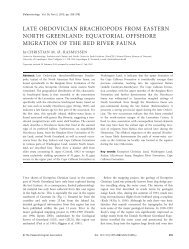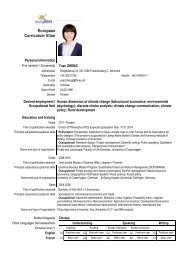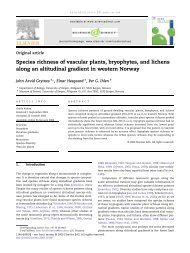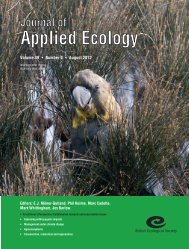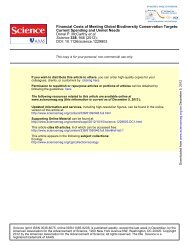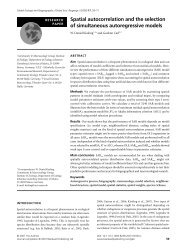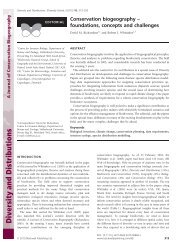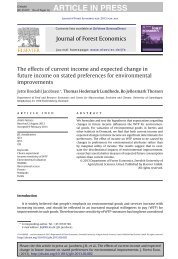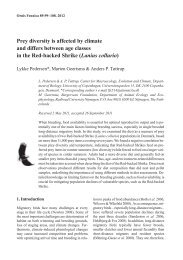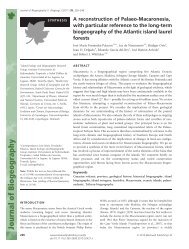climate change Habitat stability affects dispersal ... - 192.38.112.111
climate change Habitat stability affects dispersal ... - 192.38.112.111
climate change Habitat stability affects dispersal ... - 192.38.112.111
You also want an ePaper? Increase the reach of your titles
YUMPU automatically turns print PDFs into web optimized ePapers that Google loves.
Downloaded from rsbl.royalsocietypublishing.org on July 12, 2012<strong>Habitat</strong> <strong>stability</strong> <strong>affects</strong> <strong>dispersal</strong> and the ability to track<strong>climate</strong> <strong>change</strong>Christian Hof, Martin Brändle, D. Matthias Dehling, Mariana Munguía, Roland Brandl, Miguel B.Araújo and Carsten RahbekBiol. Lett. 2012 8, 639-643 first published online 29 February 2012doi: 10.1098/rsbl.2012.0023Supplementary dataReferencesEmail alerting service"Data Supplement"http://rsbl.royalsocietypublishing.org/content/suppl/2012/02/28/rsbl.2012.0023.DC1.htmlThis article cites 23 articleshttp://rsbl.royalsocietypublishing.org/content/8/4/639.full.html#ref-list-1Receive free email alerts when new articles cite this article - sign up in the box at the topright-hand corner of the article or click hereTo subscribe to Biol. Lett. go to: http://rsbl.royalsocietypublishing.org/subscriptions
Downloaded from rsbl.royalsocietypublishing.org on July 12, 2012Global <strong>change</strong> biologyBiol. Lett. (2012) 8, 639–643doi:10.1098/rsbl.2012.0023Published online 29 February 2012<strong>Habitat</strong> <strong>stability</strong> <strong>affects</strong><strong>dispersal</strong> and the abilityto track <strong>climate</strong> <strong>change</strong>Christian Hof 1,2,3, *, Martin Brändle 4 ,D. Matthias Dehling 3 , Mariana Munguía 2,5 ,Roland Brandl 4 , Miguel B. Araújo 1,2,6and Carsten Rahbek 11 Center for Macroecology, Evolution and Climate, Department of Biology,University of Copenhagen, Copenhagen, Denmark2 Department of Biodiversity and Evolutionary Biology, National Museumof Natural Sciences (CSIC), Madrid, Spain3 Biodiversity and Climate Research Centre (BiK-F) and SenckenbergGesellschaft für Naturforschung, Frankfurt, Germany4 Department of Ecology (Animal Ecology), Faculty of Biology,Philipps-Universität Marburg, Marburg, Germany5 Instituto de Biología, Universidad Nacional Autónoma de Mexico,Distrito Federal, Mexico6 Rui Nabeiro Biodiversity Chair, CIBIO, University of Évora, Évora,Portugal*Author for correspondence (christian.hof@senckenberg.de).<strong>Habitat</strong> persistence should influence <strong>dispersal</strong>ability, selecting for stronger <strong>dispersal</strong> in habitatsof lower temporal <strong>stability</strong>. As standing (lentic)freshwater habitats are on average less persistentover time than running (lotic) habitats, lenticspecies should show higher <strong>dispersal</strong> abilitiesthan lotic species. Assuming that <strong>climate</strong> is animportant determinant of species distributions,we hypothesize that lentic species should havedistributions that are closer to equilibrium withcurrent <strong>climate</strong>, and should more rapidly track climatic<strong>change</strong>s. We tested these hypotheses usingdatasets from 1988 and 2006 containing all Europeandragon- and damselfly species. Bioclimaticenvelope models showed that lentic species werecloser to climatic equilibrium than lotic species.Furthermore, the models over-predicted loticspecies ranges more strongly than lentic speciesranges, indicating that lentic species track climatic<strong>change</strong>s more rapidly than lotic species. Theseresults are consistent with the proposed hypothesisthat habitat persistence <strong>affects</strong> theevolution of <strong>dispersal</strong>.Keywords: bioclimatic envelope models; damselflies;dragonflies; freshwater; odonata; range-filling1. INTRODUCTION<strong>Habitat</strong> is an important determinant of the evolutionof life-history traits and hence the ecological characteristicsof species [1]. Broadly classified, freshwaterhabitats can be divided into standing (lentic habitats)and running water bodies (lotic habitats). Lentic habitatsare, on average, less persistent over time than lotichabitats [2,3], and this should have consequences forthe evolution of <strong>dispersal</strong> abilities of lentic and loticspecies. Specifically, we hypothesize that if their habitatsare more likely to disappear within shorterElectronic supplementary material is available at http://dx.doi.org/10.1098/rsbl.2012.0023 or via http://rsbl.royalsocietypublishing.org.periods of time, lentic species should have evolved ahigher propensity for <strong>dispersal</strong> than lotic species [3].Support for this hypothesis—hereafter referred to asthe habitat–<strong>stability</strong>–<strong>dispersal</strong> hypothesis (HSDH)—comes from several studies, which showed that lenticspecies have larger range sizes [4] and a lower geneticdiversity among populations [5,6] than lotic species.Furthermore, post-glacial re-colonization of northernEurope was probably faster for lentic than for loticspecies [7–9].Here, we test the HSDH for European dragonfliesusing bioclimatic envelope models (BEMs). BEMsare useful for projecting potential ranges based on distributiondata, and are extensively used for projectingfuture species distributions under <strong>climate</strong> <strong>change</strong>[10]. If contemporary <strong>climate</strong> is an important determinantof species distributions, distributions of specieswith stronger <strong>dispersal</strong> abilities should be closer toequilibrium with contemporary <strong>climate</strong> [11]. Therefore,these species should show higher levels of rangefilling and should be able to track climatic <strong>change</strong>smore rapidly. Range filling, the ratio of the observedversus potential range size given by BEMs (O/Pratio), has been used to infer the degree of climaticequilibrium [12–14]. According to the HSDH, lenticspecies should show a higher degree of climatic equilibrium(indicated by higher O/P ratios), and a higherability to track climatic <strong>change</strong>s, than lotic species. Ifso, then BEMs should over-predict lotic speciesranges more strongly than lentic species ranges whencomparing range <strong>change</strong>s with climatic <strong>change</strong>sbetween two distinct time periods.2. MATERIAL AND METHODSWe used digitized distribution maps drawn in 1988 and 2006 for allEuropean dragon- and damselfly species [15,16] (‘dragonflies’ hereafter;electronic supplementary material, table S1). Maps weretransferred into a Universal Transfer Mercator 50 50 km grid ofEurope (http://www.ibio<strong>change</strong>.mncn.csic.es/; [17]). We furthercompiled larval habitat preferences (lentic and lotic) and phylogeneticdata for all species. The final dataset included 88 species (seethe electronic supplementary material for details).We ran BEMs for all species using BIOMOD [18] with meanannual temperature and total annual precipitation as climatic variables[19], and using seven different modelling techniques (seefigure 1 for the BEMs used and electronic supplementary material,figure S1 for <strong>climate</strong> maps and details on data preparation). Modeloutputs were translated into presence–absence maps usingreceiver-operating-characteristic- (ROC-) and Kappa-optimizingthresholds (for more details on BEM techniques and standardfeatures of BIOMOD, see [18]).To compare the levels of range filling between lentic and loticspecies, we calculated the O/P ratio for each species and timeperiod [12,13] (see the electronic supplementary material, figureS2 for an illustration of the modelling steps and calculations). To calculatethe O/P ratio for a species in 1988 for example, we used itsobserved distribution in 1988 and climatic data for 1988 to calibratea BEM, from which we obtained the potential distribution in 1988.Then the observed range size was divided by the potential range size,to obtain the O/P ratio (electronic supplementary material, figureS2a). The effects of habitat type on O/P ratios were assessed withWilcoxon rank sum tests.To assess how well species tracked climatic <strong>change</strong>s between1988 and 2006, we also projected potential distributions for 2006based on the models calibrated in 1988. To test whether lotic speciesshowed a stronger tendency to over-prediction, we calculated modelsensitivities and specificities comparing projected and observed distributionsfor 2006 (see the electronic supplementary material,figures S2b and S3 for further details).We also accounted for possibly confounding effects of phylogenyand range size (see the electronic supplementary material). Allanalyses were run in R (v. 2.12.0; [20]).Received 9 January 2012Accepted 10 February 2012 639 This journal is q 2012 The Royal Society
Downloaded from rsbl.royalsocietypublishing.org on July 12, 2012640 C. Hof et al. <strong>Habitat</strong>, <strong>dispersal</strong> and <strong>climate</strong> <strong>change</strong>(a)1.2ANNCTAGAMGBMO/P ratio0.80.40lenticloticlenticloticlenticloticlenticlotic1.2GLMMARSMDAMEANO/P ratio0.80.40lenticloticlenticloticlenticloticlenticlotic(b)1.2ANNCTAGAMGBMO/P ratio0.80.40lenticloticlenticloticlenticloticlenticloticGLMMARSMDAMEAN1.2O/P ratio0.80.40lenticloticlenticloticlenticloticlenticloticFigure 1. Effect of habitat type on O/P ratios of European dragonflies using different BEM techniques ((a) 1988 and (b) 2006).O/P ratios were averaged across all lotic and lentic species, respectively. Differences were significant (p , 0.05, Wilcoxon ranksum test) in all cases except CTA in 1988 (p ¼ 0.068). Arithmetic means across the seven BEM techniques are indicated ingrey (‘MEAN’). Projected range sizes were transformed into presences and absences from probabilities of occurrence usingROC-optimizing thresholds. BEM technique acronyms: ANN, artificial neural networks; CTA, classification tree analyses;GAM, generalized additive models; GBM, generalized-boosting models; GLM, generalized linear models; MARS, multipleadaptive regression splines; MDA, mixture discriminant analyses. See the electronic supplementary material, figure S4 forcalculations using Kappa-optimizing thresholds, and an explanation of box-and-whisker plots.3. RESULTSO/P ratios were higher for lentic than for lotic species(figure 1); this pattern was largely independent of theBEM method used, even though the strength of thedifference may vary in some cases, especially dependingon the threshold technique used (electronic supplementarymaterial, figure S4). When accounting forphylogeny, the effect of the habitat type on O/P ratioremained significant in only a few cases, but the overalltrend (higher O/P ratio for lentic species) remained consistentin most comparisons (electronic supplementarymaterial, table S2). Range size had an influence onO/P ratio, but in most cases, especially in the first tothird range-size quartiles, lentic species still showedhigher O/P ratios (electronic supplementary material,figures S5–S8).Comparisons of observed and projected distributionsfor 2006 showed a stronger tendency forover-prediction (smaller specificities) for lotic thanlentic species ranges in the vast majority of cases(figure 2). When accounting for range size, this tendencytowards a stronger over-prediction for loticspecies was mostly supported (electronic supplementarymaterial, figures S9–S10).Biol. Lett. (2012)
Downloaded from rsbl.royalsocietypublishing.org on July 12, 2012<strong>Habitat</strong>, <strong>dispersal</strong> and <strong>climate</strong> <strong>change</strong> C. Hof et al. 641(a)1.00.80.60.40.201.00.80.60.40.20(b)1.00.80.60.40.20ANNCTAGAMGBMSen Spe Sen Spe Sen Spe Sen Spe Sen Spe Sen Spe Sen Spe Sen Spelotic lentic lotic lentic lotic lentic lotic lenticGLMMARSMDAMEANSen Spe Sen Spe Sen Spe Sen Spe Sen Spe Sen Spe Sen Spe Sen Spelotic lentic lotic lentic lotic lentic lotic lenticANNCTAGAMGBMSen Spe Sen Spe Sen Spe Sen Spe Sen Spe Sen Spe Sen Spe Sen Spelotic lentic lotic lentic lotic lentic lotic lentic1.0GLMMARSMDAMEAN0.80.60.40.20Sen Spe Sen Spelotic lenticSen Spe Sen Spelotic lenticSen Spe Sen Spelotic lenticSen Spe Sen Spelotic lenticFigure 2. Sensitivity (Sen) and specificity (Spe), averaged across all lotic (grey bars) and lentic (black bars) dragonflies, fordifferent BEM techniques, using (a) ROC- and (b) Kappa-optimizing thresholds (error bars indicate the s.e. of the mean;see §2, electronic supplementary material, methods and figures S2b and S3 for further details). Arithmetic means across theseven BEM techniques are presented in the last panels (‘MEAN’, error bars here indicate the s.d.).4. DISCUSSIONHigher O/P ratios in lentic dragonflies support thehypothesis that lentic species distributions are closerto climatic equilibrium than lotic species distributions.This is underlined by the tendency towards strongerover-prediction of lotic species ranges when comparingprojected and observed ranges for 2006. Both findingssupport the HSDH, suggesting that lower habitat<strong>stability</strong> selects for stronger <strong>dispersal</strong> abilities [3,4](see the electronic supplementary material, discussionfor details on the effects of range size, phylogeny,threshold technique and on other deviances from theoverall pattern).The observed differences in range filling could beconfounded by habitat availability, e.g. in cases whereclimatic conditions are suitable but no freshwaterBiol. Lett. (2012)
Downloaded from rsbl.royalsocietypublishing.org on July 12, 2012642 C. Hof et al. <strong>Habitat</strong>, <strong>dispersal</strong> and <strong>climate</strong> <strong>change</strong>habitats are present. This is assumed to be the case ifhabitat availability is a strong predictor of freshwaterspecies richness. However, for the geographicalextent and resolution of our study, the distribution offreshwater bodies is a weak predictor of dragonflyspecies richness [21]. Furthermore, the explanatorypower of habitat availability for species richness oflotic habitats is exceptionally low [9]. Therefore, theconfounding effect of habitat availability should berather negligible. The influence of other factors suchas pollution, anthropogenic land-cover <strong>change</strong>s orpredator occurrence [22] could also affect the results.However, as these factors either should not differentiallyaffect lotic and lentic habitats (land-cover<strong>change</strong>s) or most likely act at finer scales than thescale of our analyses (pollution and predators), weassume such effects to be of minor importance forthe extent and resolution of our analyses [23].Our results support the findings of previous studiesthat lotic species are weaker dispersers than lenticspecies [4–6]. If true, lentic species should be able totrack climatic <strong>change</strong>s more rapidly than lotic species[24]. Our analyses support this prediction, along withstudies that relate contrasting large-scale diversitypatterns in lentic and lotic species to their post-glacialre-colonization capacity [3,7,8]. It is widely acceptedthat the glacial–interglacial cycles of the Pleistoceneare still mirrored in contemporary patterns of speciesrichness in Europe [25]. As dragonflies are assumed tobe strong dispersers compared with other invertebrates,they are also expected to be able to track climatic<strong>change</strong>s more successfully [26,27]. The differential <strong>dispersal</strong>abilities of dragonflies adapted to different habitattypes suggest that similar generalizations for entire taxamay be misleading, though.Dispersal ability is of major importance for species torespond successfully to <strong>climate</strong> <strong>change</strong> (but see [28]).BEM studies projecting species distributions under<strong>climate</strong>-<strong>change</strong> scenarios usually adopt very coarse<strong>dispersal</strong> assumptions, i.e. unlimited or no <strong>dispersal</strong>.That these assumptions are unrealistic is widelyacknowledged, but as long as species-specific <strong>dispersal</strong>data are vastly lacking, multi-species BEMs rely onsuch simplifications. If habitat is indeed a generallyimportant determinant of <strong>dispersal</strong> ability [1], establishingeven simplified links between habitatpreferences, habitat <strong>stability</strong> and <strong>dispersal</strong> ability may,with an accordant model parameterization, help toovercome the over-simplistic <strong>dispersal</strong> assumptions currentlyused in models that project species responses to<strong>climate</strong> <strong>change</strong>.Thanks to Florian König and Yannic Grewe for digitizingdragonfly distributions, and to David Nogués-Bravo as well astwo anonymous referees for helpful comments. C.H. andC.R. acknowledge support of the Danish National ResearchFoundation to the Center for Macroecology, Evolution andClimate. C.H. and D.M.D. acknowledge support from theresearch funding programme ‘LOEWE—Landes-Offensivezur Entwicklung Wissenschaftlich-ökonomischer Exzellenz’of Hesse’s Ministry of Higher Education, Research andthe Arts. M.M. acknowledges support of the Posgrado enCiencias Biológicas (UNAM), the Consejo Nacional deCiencia y Tecnología and the FBBVA BIOIMPACTO project.M.B.A. was funded by EC-FP6-ECOCHANGE project,Contract-No 036866-GOCE) and by the Spanish Ministryof Science and Innovation (Complementary-Action-NoCGL2008-01198-E/BOS).1 Southwood, T. R. E. 1962 Migration of terrestrial arthropodsin relation to habitat. Biol. Rev. 37, 171–214.(doi:10.1111/j.1469-185X.1962.tb01609.x)2 Dobson, M. & Frid, C. 1998 Ecology of aquatic systems.Harlow, UK: Longman.3 Ribera, I. & Vogler, A. P. 2000 <strong>Habitat</strong> type as a determinantof species range sizes: the example of lotic–lenticdifferences in aquatic Coleoptera. Biol. J. Linn. Soc. 71,33–52.4 Hof, C., Brändle, M. & Brandl, R. 2006 Lentic odonateshave larger and more northern ranges than lotic species.J. Biogeogr. 33, 63–70. (doi:10.1111/j.1365-2699.2005.01358.x)5 Abellan, P., Millan, A. & Ribera, I. 2009 Parallel habitatdrivendifferences in the phylogeographical structure oftwo independent lineages of Mediterranean saline waterbeetles. Mol. Ecol. 18, 3885–3902. (doi:10.1111/j.1365-294X.2009.04319.x)6 Marten, A., Brändle, M. & Brandl, R. 2006 <strong>Habitat</strong> typepredicts genetic population differentiation in freshwaterinvertebrates. Mol. Ecol. 15, 2643–2651. (doi:10.1111/j.1365-294X.2006.02940.x)7 Ribera, I., Foster, G. N. & Vogler, A. P. 2003 Does habitatuse explain large scale species richness patterns ofaquatic beetles in Europe? Ecography 26, 145–152.(doi:10.1034/j.1600-0587.2003.03271.x)8 Hof, C., Brändle, M. & Brandl, R. 2008 Latitudinal variationof diversity in European freshwater animals is notconcordant across habitat types. Global Ecol. Biogeogr.17, 539–546. (doi:10.1111/j.1466-8238.2008.00394.x)9 Dehling, D. M., Hof, C., Brändle, M. & Brandl, R. 2010<strong>Habitat</strong> availability does not explain the species richnesspatterns of European lentic and lotic freshwater animals.J. Biogeogr. 37, 1919–1926.10 Elith, J. & Leathwick, J. R. 2009 Species distributionmodels: ecological explanation and prediction acrossspace and time. Annu. Rev. Ecol. Evol. Syst. 40, 677–697.(doi:10.1146/annurev.ecolsys.110308.120159)11 Araújo, M. B. & Pearson, R. G. 2005 Equilibriumof species’ distributions with <strong>climate</strong>. Ecography 28,693–695. (doi:10.1111/j.2005.0906-7590.04253.x)12 Svenning, J. C. & Skov, F. 2004 Limited filling of thepotential range in European tree species. Ecol. Lett. 7,565–573. (doi:10.1111/j.1461-0248.2004.00614.x)13 Munguía, M., Peterson, A. T. & Sánchez-Cordero, V.2008 Dispersal limitation and geographical distributionsof mammal species. J. Biogeogr. 35, 1879–1887.(doi:10.1111/j.1365-2699.2008.01921.x)14 Munguía, M., Rahbek, C., Diniz Filho, J. A. F., Rangel,T. F. L. V. B. & Araújo, M. In press. Equilibrium of globalamphibian species distributions with <strong>climate</strong>. PLoS ONE.15 Askew, R. R. 1988 The dragonflies of Europe. Colchester,UK: Harley Books.16 Dijkstra, K. D. B. & Lewington, R. 2006 Field guide to thedragonflies of Britain and Europe. Gillingham, UK: BritishWildlife Publishing.17 Nogués-Bravo, D. & Araújo, M. B. 2006 Species richness,area and <strong>climate</strong> correlates. Global Ecol. Biogeogr.15, 452–460. (doi:10.1111/j.1466-822X.2006.00240.x)18 Thuiller, W., Lafourcade, B., Engler, R. & Araújo, M. B.2009 BIOMOD: a platform for ensemble forecasting ofspecies distributions. Ecography 32, 369–373. (doi:10.1111/j.1600-0587.2008.05742.x)19 Mitchell, T. D. & Jones, P. D. 2005 An improved method ofconstructing a database of monthly <strong>climate</strong> observationsBiol. Lett. (2012)
Downloaded from rsbl.royalsocietypublishing.org on July 12, 2012<strong>Habitat</strong>, <strong>dispersal</strong> and <strong>climate</strong> <strong>change</strong> C. Hof et al. 643and associated high-resolution grids. Int. J. Climatol. 25,693–712. (doi:10.1002/joc.1181)20 R Development Core Team 2010 R: a language andenvironment for statistical computing, version 2.12.0.Vienna, Austria: R Foundation for Statistical Computing.21 Keil, P., Simova, I. & Hawkins, B. A. 2008 Water-energyand the geographical species richness pattern of Europeanand North African dragonflies (Odonata). InsectConserv. Diver. 1, 142–150. (doi:10.1111/j.1752-4598.2008.00019.x)22 Hassall, C. & Thompson, D. J. 2008 The effects ofenvironmental warming on Odonata: a review.Int. J. Odonatol. 11, 131–153.23 Pearson, R. G. & Dawson, T. P. 2003 Predicting theimpacts of <strong>climate</strong> <strong>change</strong> on the distribution of species:are bio<strong>climate</strong> envelope models useful? Global Ecol.Biogeogr. 12, 361–371. (doi:10.1046/j.1466-822X.2003.00042.x)24 Heino, J., Virkkala, R. & Toivonen, H. 2009 Climate<strong>change</strong> and freshwater biodiversity: detected patterns,future trends and adaptations in northern regions. Biol.Rev. 84, 39–54. (doi:10.1111/j.1469-185X.2008.00060.x)25 Araújo, M. B., Nogues-Bravo, D., Diniz-Filho, J. A. F.,Haywood, A. M., Valdes, P. J. & Rahbek, C. 2008 Quaternary<strong>climate</strong> <strong>change</strong>s explain diversity among reptilesand amphibians. Ecography 31, 8–15. (doi:10.1111/j.2007.0906-7590.05318.x)26 Hickling, R., Roy, D. B., Hill, J. K. & Thomas, C. D.2005 A northward shift of range margins in BritishOdonata. Glob. Change Biol. 11, 502–506. (doi:10.1111/j.1365-2486.2005.00904.x)27 Clausnitzer, V. et al. 2009 Odonata enter the biodiversitycrisis debate: the first global assessment of an insectgroup. Biol. Conserv. 142, 1864–1869. (doi:10.1016/j.biocon.2009.03.028)28 Hof, C., Levinsky, I., Araújo, M. & Rahbek, C. 2011Rethinking species’ ability to cope with rapid <strong>climate</strong><strong>change</strong>. Glob. Change Biol. 17, 2987–2990. (doi:10.1111/j.1365-2486.2011.02418.x)Biol. Lett. (2012)



